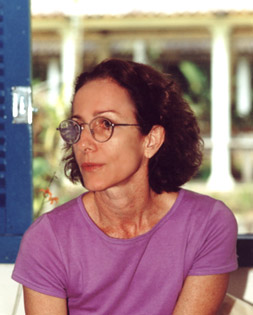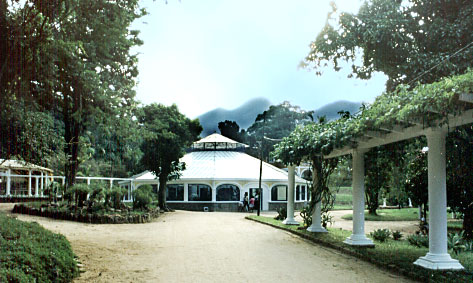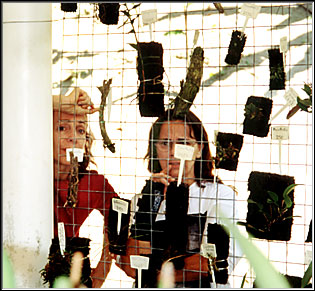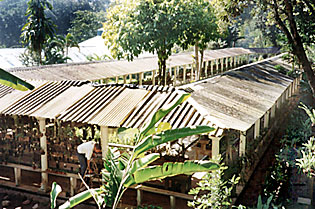

 |
 |
||
| Interview with Marta Moraes, biologist, manager of the Orchid Houses of the Botanical Garden of Rio de Janeiro. |
 |
| ON: Marta, in our first edition, in 1997, you told us about the recuperation of the Orchid Houses and the projects. Four years later, knowing the innumerable difficulties, we would like to know what has been already done, which are the new projects and which one are in course. |
| Marta Moraes: First of all, along those years, we have been attracting the public with a well-managed nursery, with wonderful plants, quite well identified, with basic information about the orchids and a daily attendance. We maintain a collection which is not big, but with very interesting plants, not usually found in private collections. |
|
Although without information, we can presume that some of those orchids have been collected by important botanists such us Campos Porto, Brade and, perhaps, Barbosa Rodrigues. We have increased a little the scientific collection with some collecting done by Toscano de Brito (botanist) until 1999, do Gustavo Martinelli (expert in bromeliad) and, nowadays, by Gabriel Cattan (employee of the Orchid Houses). Some exchanges with collectors, purchases and donations by commercial nurseries have been helping to maintain our place blooming the most part of the time. All data about the collection is already stored using a specific computer program to botanical gardens. Not only storing the data, but also up-dating them has been being one of the priority of the Orchid Houses and one of pilot-projects of the Botanical Garden of Rio de Janeiro |
 Marta and Delfina |
| ON:
And how is going the partnership with the jeweler Antonio Bernardo? How does the contract work? Marta: The sponsorship has been renewed twice, for periods of two years. We are in the sixth years, which finishes in August and we hope it will be renewed once again. The contract with Antonio Bernardo is very simple. He maintains the live collection, hiring two gardeners and a biologist (me) who supervises the gardeners and manages the place in order to maintain the plants in good conditions and blooming, consequently, maintain the good image of the sponsor. He still provides the basic materials to cultivation. He also had the commitment of paying a salary to a specialist in the family, designated by the Botanical Garden. As there is no more this researcher in the Garden, in the last renewal, we had it omitted. In exchange, the sponsor can use the Botanical Garden's Orchid Houses to organize events to promote his company. |
| ON:
Although the superior system of irrigation has been, in some way, improved, the glass greenhouse (called Orchideario - the octagon and the corridor) has been always considered as a difficult place to cultivate due to its structure and the glass roof which propitiate an extreme high temperature, during the springtime and the summer. Why does not change it ? Is true that the greenhouse can not be modified or is it a legend? |
|
| Marta:
That is all right. We can't change it but there is some malleability. If IPHAN (Institute for National Patrimony) is convinced that a change is necessary, they analyze. ON: Would be there a remote, delirious possibility of conserving here as a monument, reserved for shows and create another place, within the Botanical Garden, with more modern conditions? Marta: Sure, we think about constructing a good nursery. However there are some orchids that thrive wonderfully here. We have had an offer from a company in São Paulo, which constructs since very small, like "do it yourself", until big nurseries to vegetable farms. This company has been recommended by Maurício Verboonen (Binot nurseries). Someone came to do a study about the possibility of refrigerating and improving the conditions of this place. He stayed very long, asked me to take notes, left a barometer, we verified the level of humidity inside, twice a day, we took the temperature and every thing. He did a rapport telling what should be done in order to let it a little cooler. We should put an aluminum wire fencing all around, inside, which would refracts the heat, put electric fans, exhausters, many things, it would be very expensive. It was impossible to do but they offer us to do a small nursery. It would be a kind of publicity but this subject, unfortunately, ended. ON: How? Marta: I don't know. By this time, an orchidist from Oxford, who is mad about rupicolous laelias, appeared. He comes to Brazil, every two years; he goes to everywhere, photographs everything, goes back and gives lectures. He sees that every year, the environment is more deteriorated and thinks it would be very interesting to do a study about them. He talked to Toscano that he wanted to give some money to someone who studies them. He doesn't have a lot of money but he would like to encourage someone, a student, for example, to take this job in field, a kind of grant-aided, something almost symbolic. Toscano said that we couldn't cultivate them here, unless we have an acclimated greenhouse. His idea was not to invest money in greenhouses nor anything, he wanted to encourage people. By this time, there was this possibility of receiving a small greenhouse to cultivate rupicolous laelia, which would fit between the greenhouse and the lath house. Don't ask me why it did not work because I was not involved in those negotiations. Everything was discussed with Toscano and he left here. The story of rupicolous laelia ended, the history of the greenhouse ended. |
| ON:
Have they met each other, the orchidist and that person from the company?
Marta: No, although the facts happened concomitantly and Toscano would be the connection. This person went away and I though he would never come back. However, he came this year and is still looking for someone. During the show, in June, I asked Marco Campacci (orchid researcher) if he would be interested in contact him since he knows a lot about rupicolous laelias. I gave his telephone number and when he came here, he had already contacted him and made an appointment in São Paulo with Campacci. ON: Are the Orchid Houses a part of the Botanical Garden? Have you autonomy for signing accords, organizing events, for example? Marta: No, I haven't. Of course, I should submit to the Board of directors' approval. ON: And the internal problems concerning the Orchid Houses, are you able to decide about? |
| Marta:
It depends on what you are talking about. For the physical structure, I
depend on them for everything, if the water-pump breaks down, if a glass
breaks. For example, this year (2001), the budget does not allow any expense.
The roof of the lath house should have been changed since the beginning
of the works and until now it has not been changed yet. ON: Which can inhibit or even prevent flowering. Marta: Too much, too much. We washed everything during the work of repairs, then once again but now I am giving up because everything is so old, so fragile. |
 Lath house of the Botanical Garden |
| ON:
If you get a sponsorship from a company that makes special roofs in order to change everything, you ought to submit to them? Is that possible? Does the organizational structure allow it? Marta: Yes, I should submit to the Board as usual but the structure allows it, perfectly. ON: How knows? Perhaps, suddenly, someone becomes interested in doing something. With so many specialized societies in constructing roofs, coverings. It is not too much expensive to change those coverings. Marta: It is not so cheap. ON:For a company? Marta: For a company, it is not but for us, it is too expensive. I have asked for a budget thousands times. The last budget, if I am not wrong, was something about R$10.000,00 (ten thousand reais). ON: R$ 10.000,00 to a big company, this is nothing. Marta: But it is something to the Botanical Garden. |
|
ON:
Marta, why do other institutions not also sponsor the Orchid Houses? Why events are not promoted since, besides everything, the architecture of the glass greenhouse is really very beautiful?
Does sponsor ask for exclusivity? Marta: No, he doesn't if the company is not in the same business, of course. He always makes it clear, if we want to look for another sponsorship, since it is not a question of jewellery, it is OK to him and he thinks it is great. Events are very hard and expensive, so they need financial contribution, project, we need to knock from one door to another asking for a sponsorship, productions... I suggested some themes but I am not a producer. The sponsor likes the idea, first of all, for loving the subject and the Orchid Houses, he has no interest in promoting his business with this. Neither the Botanical Garden is special worried about attracting public as it has already a visitation guarantee. Who could be interested in promoted events here? OrquidaRio could be the main interested. I feel that there is a general difficulty to separate orchidophilie from trade. It is complicated. Events that promote orchids are always welcome here however those with commercial intent, to sell orchids, have a limit. To the sponsor, as much as calling attention, it is better. For example, Toscano wanted to get resources from a company to do a excursion, colleting, etc. and Antônio Bernardo did not oppose but it is necessary to have someone to do this job, otherwise, the botanist changes to another position. ON: Of course, the function of a botanist is not to look for a sponsor. You should have a professional to look for getting subsidy. Marta: Nowadays, the Botanical Garden has a department for this but everything is very new. |
| It is expressly forbidden any kind of usage of any material of this site (text, photos, images, lay-out and any other), without the express authorization from the authors. |